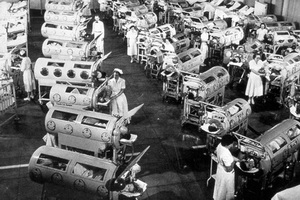Polio + Prevention
Polio is a crippling and potentially fatal infectious disease. There is no cure, but there are safe and effective vaccines. The strategy to eradicate polio is therefore based on preventing infection by immunizing every child until transmission stops and the world is polio-free.
Polio (poliomyelitis) is a highly infectious disease caused by a virus. It invades the nervous system and can cause irreversible paralysis in a matter of hours.
Polio can strike at any age, but it mainly affects children under five years old.
Polio is spread through person-to-person contact. When a child is infected with wild poliovirus, the virus enters the body through the mouth and multiplies in the intestine. It is then shed into the environment through the faeces where it can spread rapidly through a community, especially in situations of poor hygiene and sanitation. If a sufficient number of children are fully immunized against polio, the virus is unable to find susceptible children to infect, and dies out.
Young children who are not yet toilet-trained are a ready source of transmission, regardless of their environment. Polio can be spread when food or drink is contaminated by faeces. There is also evidence that flies can passively transfer poliovirus from faeces to food.
Most people infected with the poliovirus have no signs of illness and are never aware they have been infected. These symptomless people carry the virus in their intestines and can “silently” spread the infection to thousands of others before the first case of polio paralysis emerges.
For this reason, WHO considers a single confirmed case of polio paralysis to be evidence of an epidemic – particularly in countries where very few cases occur.
Most infected people (90%) have no symptoms or very mild symptoms and usually go unrecognized. In others, initial symptoms include fever, fatigue, headache, vomiting, stiffness in the neck and pain in the limbs.
Acute flaccid paralysis (AFP)
One in 200 infections leads to irreversible paralysis, usually in the legs. This is caused by the virus entering the blood stream and invading the central nervous system. As it multiplies, the virus destroys the nerve cells that activate muscles. The affected muscles are no longer functional and the limb becomes floppy and lifeless – a condition known as acute flaccid paralysis (AFP).
All cases of acute flaccid paralysis (AFP) among children under fifteen years of age are reported and tested for poliovirus within 48 hours of onset.
Bulbar polio
More extensive paralysis, involving the trunk and muscles of the thorax and abdomen, can result in quadriplegia. In the most severe cases (bulbar polio), poliovirus attacks the nerve cells of the brain stem, reducing breathing capacity and causing difficulty in swallowing and speaking. Among those paralysed, 5% to 10% die when their breathing muscles become immobilized.
 |
| In the 1940s and 1950s, people with bulbar polio were immobilized inside “iron lungs” – huge metal cylinders that operated like a pair of bellows to regulate their breathing and keep them alive. Today, the iron lung has largely been replaced by the positive pressure ventilator, but it is still in use |
Around 40% of people who survive paralytic polio may develop additional symptoms 15–40 years after the original illness. These symptoms – called post-polio syndrome – include new progressive muscle weakness, severe fatigue and pain in the muscles and joints.
No one knows why only a small percentage of infections lead to paralysis. Several key risk factors have been identified as increasing the likelihood of paralysis in a person infected with polio. These include:
- immune deficiency
- pregnancy
- removal of the tonsils (tonsillectomy)
- intramuscular injections, e.g. medications
- strenuous exercise
- injury
There is no cure for polio, only treatment to alleviate the symptoms. Heat and physical therapy is used to stimulate the muscles and antispasmodic drugs are given to relax the muscles. While this can improve mobility, it cannot reverse permanent polio paralysis.
Polio can be prevented through immunization. Polio vaccine, given multiple times, almost always protects a child for life.







